March 2019, with the exception of a short snowy spell mid-month, saw spring arrive unseasonably early in this area. Though with temperatures fluctuating wildly from -6c to +19c during the month, prospective visitors would be wise to keep an eye on the weather forecast, and bring a selection of clothes and footwear to suit all seasons and all weathers!
The days are lengthening nicely now though, with nearly 12 hours of usable daylight, and dawn (for the Black Grouse lek) is a still not too unsociable 6am, and with the Daffodils joining the Crocuses and Snowdrops, many birds now singing, Frogs and Toads on the move and Bumble Bees on the wing, I think it may now be safe to declare that winter is almost over....
With many of the winter visiting birds still here, and a few wader and water bird species returning to their inland breeding sites in the second half of the month, full-day safari bird species day-lists crept up over the 40 mark, though a trip to the nearby Moray Coast can boost this total considerably, whilst mammal species day-lists varied between 3 and 8 depending on our luck, time of start, and the variety of habitats visited, with early starts usually proving most fruitful.
I was away down in southern England visiting family and friends for part of the month, so my local sightings report will be a little shorter than usual and may include a few photos from previous March safaris that are representative of the month.
 |
| On safari in the snowy Cairngorm Mountains |
To give you an idea of what you may realistically hope to see if you are planning a future
March visit yourself, I hope the following more detailed information, illustrated with photos taken in and around the Cairngorms National Park and nearby Moray coast, by myself , my friends or my safari clients will help - clicking on the picture will enlarge it to full screen.
Wildlife highlights included:
Local speciality/upland bird species seen regularly included Black Grouse (dawn only) , Red Grouse, Crested Tit (early in the month and on colder days only), Snow Bunting, Goldeneye , Goosander, and Dipper, we also had a couple of distant views of soaring Golden Eagle and one quite close sighting of a White-Tailed Eagle, and from mid-month, our first local reports this year of Red-Throated Diver, Black-Throated Diver and Golden Plover - all coming into their splendid summer breeding plumage - and at the very end of the month, our first Osprey, Slavonian Grebe and Ring Ouzels joined the ever-increasing numbers of other Summer visiting birds , such as Lapwing, Oystercatcher and Curlew.
And finally, at the 14th attempt!!, a dawn walk in Caledonian forest at last produced a (3 second) glimpse of a (male) Capercaillie for me....though my safari clients , sadly, have still to see one with me this year....
Although I personally did not go on any mountain top adventures for Ptarmigan this month, I understand that they could sometimes be seen well on the days when the weather was suitable....
Winter visiting birds were represented by a few remaining family groups of
Whooper Swans, flocks of
Greylag Geese and
Pink-Footed Geese, wildfowl such as
Wigeon and Teal, a few (again annoyingly mobile)
Waxwings continued to feast on our now almost totally depleted berries throughout the month..and a few
Redwings ,
Fieldfares,
Redpolls and
Bramblings lingered....whilst the
Great Grey Shrike (last reported in Feb) suddenly reappeared on the 25th!
A good variety of
seabirds,
waders, wildfowl and
Geese were enjoyed at the
Moray Coast and the nearby inland lochs...
Mammals seen regularly locally during the month included:
Roe Deer, Red Deer, Reindeer, Red Squirrel, Rabbit, Mountain Hare (still mainly
white
), and
Mountain Goat (now with young), and a few sightings of
Brown Hare ...
Common Seal and
Grey Seal were both seen at the nearby Moray Coast...
March 2019 bird sightings in more detail:
 |
| Take your partners for the 'Blackcock tango'!! |
Black Grouse are not an easy species to see in most of the UK now, mainly being birds of remote upland moors, preferably with forests and a grassy 'lekking' patch nearby, a very specific combination of habitats that is not so common nowadays. Fortunately, the Scottish Highlands still has a decent number of active 'lek' sites, where the cock birds gather to 'strut their stuff', and dawn (about 6 am in March) on my safaris in the first five months of the year is usually spent enjoying this memorable experience. 'Performances' were noticeably better on still, frosty mornings.... but please be aware that sightings are not guaranteed, and the birds can fail to show in very mild or wet and windy weather, or if disturbed by a predator or wandering sheep, cattle or horses....
 |
| Male Red Grouse |
On the upland heather moorlands, our local
Red Grouse have most definitely already paired-up, and the cock birds, with red 'eyebrows' aglow, seem to be concentrating more on defending their territory and partner from rival birds, often posturing aggressively from the higher parts of the moor whilst cackling loudly, and the 'disappearance' of some of the hen birds late in the month suggests that a few may already be on nests...
 |
| Crested Tit |
In the Caledonian pine forests,
Crested Tits were seen at and around my favourite feeding stations early in the month, giving several of my (often very excited) safari clients a much wanted 'life-tick', but after my return from down south, with the temperatures rising, they often failed to show during the latter part of the month, and when they did they didn't stay for long and rarely called, suggesting perhaps, that they are now concentrating on breeding rather than feeding.....
As I mentioned last month, it is well worth noting that the colder winter months (October-Feb) are actually the best time of year for seeing the 'wee Cresties', as these characterful little birds can be frustratingly secretive, unobtrusive and almost silent during the breeding season, with sightings being much more difficult to obtain between March and September....
Continuing the forest theme, sadly, it was back to 'business as usual' for our
Crossbill sightings this month, as we were limited to very brief glimpses of birds flying over, with us only being able to identify them by their characteristic 'jip-jip' calls".....
Still in the forests, as I mentioned earlier, I finally got my first glimpse - all 3 or 4 seconds of it before it flew off - of a
Capercaillie this month....a cracking male bird....though it has taken me 14 dedicated pre-dawn walks in secluded areas where I have seen them in the past, to achieve this... and now we are into 'lekking' season, I will be 'responsible' by staying out of 'sensitive' areas at dawn through April and May to allow this now very rare and declining bird to (hopefully) breed in peace....
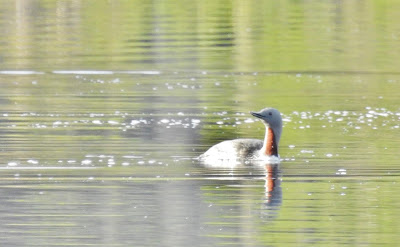 |
| Red-Throated Diver |
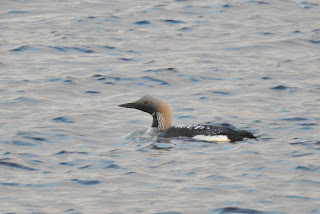 |
| Black-Throated Diver |
 |
| Slavonian (horned) Grebe |
It was better news on our local lochs though, as from mid-late month it was great to see the return of some of our rarest and in my opinion, most beautiful local speciality birds, namely
Red-Throated Diver, Black-Throated Diver and
Slavonian Grebe.
Speyside is at the south-westerly edge of the world-wide breeding range for these very sought-after species, and I am always very happy (and relieved) to see them back on their favourite waters....
 |
| Drake Goldeneye |
Also on the lochs (and rivers), we must not forget our breeding
Goldeneye population , and we were fortunate enough to see them regularly this month, with many of the males now performing their unique and spectacular 'head-banging' mating display!
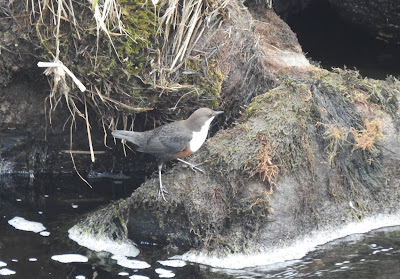 |
| Dipper |
Dippers were seen frequently on local rivers this month, and they too seem to have procreation on their minds, as we are now (presumably) only seeing male birds, and they appear to be delivering nesting material to their mates and defending territory near their favourite nest sites of old bridges....
 |
| A very distant Golden Eagle hunting low over a ridge |
 |
| Add caption |
Common Buzzard
 |
| Peregrine Falcon |
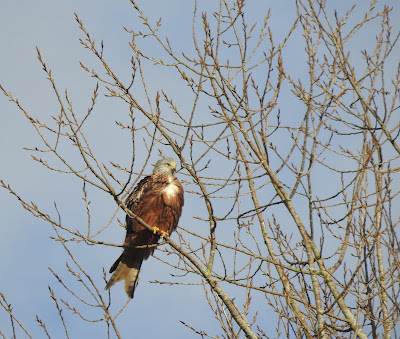 |
| Red Kite |
 |
| Kestrel |
 |
| Male Sparrowhawk |
As I have mentioned before, the shorter days of the winter months (Oct-Feb) give us our best chance of seeing
Golden Eagles and
White-Tailed Eagles although as the days lengthen, the frequency of sightings definitely reduces, and despite the adult females presumably nesting by now, we were still fortunate enough to enjoy a few decent (if distant) sightings of these majestic birds hunting in upland glens,
Raptors in general were fairly well represented this month, with
Kestrel,
Sparrowhawk,
Common Buzzard, Peregrine, Goshawk and
Red Kite all being seen at least once...and the first returning
Ospreys have been reported in the last few days...
 |
| Snow Bunting |
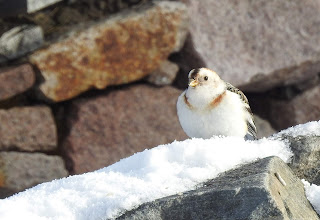 |
| Snow Bunting |
March is often our last chance to see
Snow Buntings at lower levels in this area, as the snow line tends to recede higher with each month now, and the birds tend to follow it, and true to form, we enjoyed some nice close-up sightings early in the month, but did not do so well after mid-month..
With the Cairngorm Funicular Railway still closed for the foreseeable future, I did not venture up the mountain this month, though it would appear that some hardy and very athletic souls managed to see
Ptarmigan by walking up to the snow line..
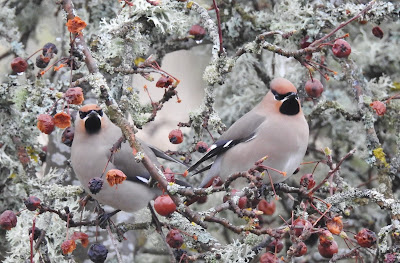 |
| Waxwings |
Moving onto winter-visiting birds ,
with hardly any berries left now, our few remaining Waxwings became even more mobile in their search for food so sightings were very patchy, ...but early in the month we still managed some great views, and I even managed a few decent photos..
 |
| Bramblings |
Similarly, Bramblings too became considerably less common, though again, we did manage some excellent sightings early in the month....
Other good birds seen or reported locally this month included:
Whooper Swan, Goosander, Goldeneye, Redpoll, Bullfinch and Great Grey Shrike....
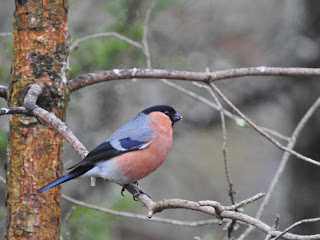 |
| Male Bullfinch |
 |
| Whooper Swans |
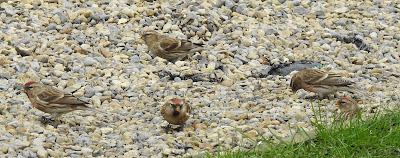 |
| Lesser Redpolls |
 |
| Late winter at a local loch |
Moray Coast highlights:
The Moray coast is only about a one hour drive north of Aviemore, and my trips to favourite reserves, lochs, bays and harbours gave good views of wintering birds such as Greylag Geese, Pink-Footed Geese, Whooper Swan, Eider, Wigeon, Teal, Scaup, Pintail, Bar-Tailed Godwit, Black-Tailed Godwit, Knot, Golden Plover, Ringed Plover, Purple Sandpiper, Common Scoter, Velvet Scoter, Red-Throated Diver, Guillemot, Goosander, Red-Breasted Merganser, and Long-Tailed Ducks....though not in the numbers seen last month....as most of the birds are presumably now drifting off to their breeding grounds...
 |
| Pink-Footed Geese |
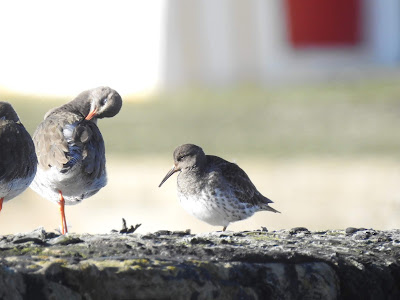 |
| Purple Sandpiper |
 |
| Curlew |
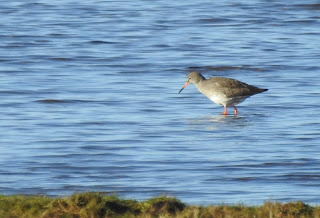 |
| Redshank |
 |
| Long-Tailed Duck |
 |
| Burghead Bay viewed from Roseisle on the Moray coast |
March 2019 mammal sightings in more detail:
 |
| Mountain Hare |
March is the last month to see our local Mountain Hares in their beautiful all-white winter coats, though a few were definitely starting to morph into their spring blue/grey colours, but they were undoubtedly 'mammal of the month', with many of my safari clients delighted to see them, often for the first time, and with their upland habitats being relatively snow-free for much of the month, they were not too difficult for me to find, and could actually be quite confiding, often allowing a reasonably close approach for photography....
 |
| Red Deer in their typical upland habitat |
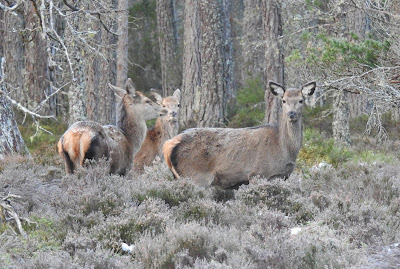 |
| Red Deer seen in Abernethy Forest |
Red Deer are most commonly seen in remote upland glens, and that was mainly the case again this month, however, when the weather turns really wintry, they sometimes desert the exposed uplands for the shelter of nearby forests, and that was the case in the middle part of this month...
 |
| Feral Mountain Goats |
Still up in the glens, we at last got to see the Feral Mountain Goats with their very cute youngsters, and they proved to be very popular with my safari clients, many of whom were unaware that there are 'wild' populations of these very interesting animals in remote parts of the UK...
 |
| Roe Deer |
Roe Deer were seen on most of my safaris this month, usually soon after dawn, but being one of the more 'nervous' animals, they invariably 'disappear' upon noticing us, but I did manage a couple of snatched long-distance photos....
Red Squirrels are pretty reliable visitors to the quieter forest feeding stations, especially during the colder weather, and we managed to see at least one, and often more, on every safari this month, and we also had some nice random sightings in more natural settings too...
Joining our early Frogs, Toads and Bumblebees, this month also saw us getting our first sightings this year of Bats and day-flying Moths......
 |
| Late winter on a local heather moorland |
Summary:
Looking back through my reports and pictures for this month, my safari clients certainly seemed to enjoy themselves, and I reckon we did pretty well despite the changeable and sometimes challenging weather.
We saw plenty of lingering winter birds, a few newly-arrived summer birds, a good selection of indigenous local specialities and also had a few rarities to entertain us, and after a week off, I now feel that I have 'fully charged batteries' ready for my favourite and busiest part of the wildlife calendar.... Spring... bring it on!
I know a lot of visitors to this area very wisely check out reviews of attractions at tripadvisor before 'taking the plunge' and booking - if you wish, you can check out my clients comments at the link below....thanks to all those that have made the effort to post me a review..... just cut and paste it into your web browser...
https://www.tripadvisor.co.uk/Attraction_Review-g186537-d3335134-Reviews-Highland_Wildlife_Birdwatch_Safaris-Aviemore_Aviemore_and_the_Cairngorms_Scottish.html
If you think you know someone who may enjoy a taste of what I do, why not treat them to a safari gift certificate. They make a thoughtful and imaginative present, are available for any amount and are valid at any time within a year from date of purchase....






